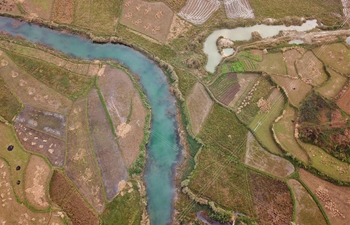WASHINGTON, Nov. 1 (Xinhua) -- Harvard scientists created a first-of-its-kind cellular map of an important region in the brains of mice with a cutting-edge imaging technology, a progress that may reveal how brain cells are linked to human behaviors.
The researchers reported in a study published on Thursday in the journal Science that they examined more than one million cells in a 2 millimeter by 2 millimeter by 0.6 millimeter block of brain.
They identified over 70 different types of neurons, most of which were previously unknown, and pinpointed where the cells were located and how they functioned, according to the study.
"This work in itself is a breakthrough because we now understand several behaviors in ways that we never did before, but it's also a breakthrough because this technology can be used anywhere in the brain for any type of function," said the paper's co-senior author Catherine Dulac, Higgins Professor of Molecular and Cellular Biology at Harvard.
MAKING BARCODES
Dulac's team used an imaging technique called MERFISH developed by Zhuang Xiaowei, another Harvard professor and co-senior author of the paper.
The MERFISH can assign "barcodes" to the cell's RNAs, hybridizing them with a library of DNA probes to represent these barcodes, and then reading out those barcodes by imaging to determine the identity of individual RNA molecules, according to the study.
Instead of using all possible barcodes, in which a single error could cause one code to be misread as another valid code, Zhuang's team selected a subset of barcodes which can only be misread if multiple errors occur simultaneously, dramatically reducing the chance of making errors.
"Different cell types have different gene expression profiles. Hence, these gene expression profiles provide a quantitative and systematic way for cell type identification," said Zhuang. "And because we can do this in intact tissues by MERFISH imaging, we can provide the spatial organization of these cell types too."
Then, Dulac, Zhuang and her colleagues focused on the hypothalamus, a brain area linked to thirst, feeding, sleep, and social behaviors like parenting and reproduction.
They used MERFISH and single-cell RNA sequencing to simultaneously image more than 150 genes throughout the preoptic region of the hypothalamus, identifying cell types in situ and creating a spatial map of where cells were located.
"You can see which neurons are neighboring each other...and not only that, but because our images are molecular, you can identify how these cells are communicating with each other," said Zhuang.
Also, "we were able to identify lowly expressed genes that are critical to cell function," added Zhuang.
BUILDING LINKS
Now, the team tried to link specific cells with specific behaviors, and they focused on a gene called c-Fos, known as an "immediate early" gene, whose transcription is increased during neural activity.
If researchers are able to track which cells show increases in the gene, they can identify cells that are activated during particular behaviors. "If we allow an animal to perform parenting, for example, we know what genes are expressed in cells that are c-Fos positive," Dulac said.
"This is extraordinarily precise, extremely quantitative, and we can see where those cells are," said Dulac. "So it's a cellular map, a molecular map, and a functional map, all together."
They also identified cells responsible for aggression and mating, and revealed intriguing differences depending on whether mice were parents or virgin males or females.
Going forward, they plan to further look at the structure of the hypothalamus, devising ways to better understand how cells are connected to one another.

















